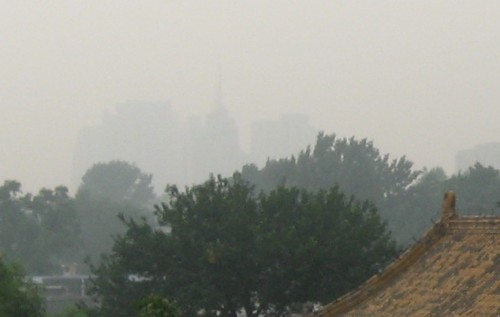Note: Please take all of my “calculations” below with a huge grain of salt. I’m not a statistician, a mathematician, an air quality expert, or a public health expert (the truth comes out – I’m not much of anything).  As always, comments are welcome!
I’m back! It’s been a hectic few months, but now I’m newly unemployed and back in the driver’s seat. So let’s go.
As you may have heard, the air quality in Beijing is just shy of phenomenal.  In March 2009, ECA International, a global human resources service company, ranked Beijing as the city with the second worst air pollution in the world, behind only New Delhi.
Back in 2000, I spent a summer in Beijing and almost forgot that they sky is supposed to be blue. This summer, I’ve seen blue skies twice so far.  Despite this anecdotal evidence of improvement, the air quality here is still dismal, a fact that even the mayor of Beijing acknowledged earlier this year. Here’s a picture I took this afternoon:
And here’s a close-up of the barely visible high-rises near the center of the picture above:
Lately, I’ve been obsessively checking the U.S. Embassy’s hourly air quality measurement reading. (Department of State, you might want to proofread that Beijing air quality webpage. You’re making us look like amateurs!) My favorite incarnation of the measurement display is this one. Here’s a screenshot from this afternoon:
The number displayed is the Air Quality Index (AQI) according to the concentration of fine particulate matter in the air. Fine particulate matter, defined as particles 2.5 microns or smaller in diameter, is especially harmful because it is too small to be filtered by our nose hairs and mucous membranes and can directly penetrate into the deepest reaches of our lungs. Effects of long-term PM2.5 exposure include asthma, permanent lung damage, lung cancer, and even heart trouble.
To see the actual PM2.5 concentration, go directly to the U.S. Embassy’s Twitter Feed. At 1:00 PM today, the PM2.5 reading was 204 micrograms per cubic meter. To give you some idea of how bad this is, the U.S. EPA’s National Ambient Air Quality Standards mandate a 24-hour average of 35 micrograms per cubic meter or lower at each monitoring site.
Another point of comparison:Â Â according to the U.S. government website Airnow.gov, the forecasted PM2.5 AQI for the Los Angeles area today was 58, which corresponds to a PM2.5 concentration of 18.3 micrograms per cubic meter.
You get the idea – Beijing’s air is really polluted. But practically speaking, what does this mean for the people who live here, breathing in this toxic soup on a daily basis? The answer: shorter, nastier lives.
A Harvard-BYU study published last year in the New England Journal of Medicine quantified the effect of PM2.5 pollution on life expectancy using a quarter century of data in 51 U.S. cities, and the results are brick-shit terrifying:
“Indirect calculations point to an approximate loss of 0.7 to 1.6 years of life expectancy that can be attributed to long-term exposure to fine-particulate matter at a concentration of 10 μg per cubic meter…In the present analysis, a decrease of 10 μg per cubic meter in the fine-particulate concentration was associated with an estimated increase in life expectancy of approximately 0.61±0.20 year — an estimate that is nearly as large as these indirect estimates.” (emphasis added)
I do not know what the average PM2.5 concentration is in Beijing, but let’s assume that it’s 100 micrograms per cubic meter, about half what it was today. And let’s say that the average in LA is 37 micrograms per cubic meter, about double what was forecast today. By using these extremely conservative figures ([(100 – 37)/10]*0.61) , I’m losing about 3.8 years by living here rather than LA!
Now let’s make the calculation using more extreme (and admittedly ridiculous) figures: assume 204 micrograms per cubic meter for Beijing’s average PM2.5 concentration, compared to today’s conditions in Portland, Oregon, where the AQI was 23, corresponding to a PM2.5 concentration of 7 micrograms per cubic meter. I could be sacrificing up to 12 years ([204-7)/10]*0.61) of my life!! And my remaining years will probably be extremely painful, wracked with bronchitis, asthma, emphysema, lung cancer and heart trouble. I do have a bit of a death wish, but I prefer to enjoy good health while I’m still here!
Completely unaccounted for are the negative effects of the severe water pollution and food-related toxins through which I slog, waist-deep, every single day. When it’s all summed up, I may not have many more days on this earth!
Note:Â For more in-depth discussion about air quality in China and issues with different measurement standards, check out Vance’s excellent blog and this paper by Steven Andrews at the Wilson Center.



August 3, 2010 at 06:01
don’t die!!!
August 4, 2010 at 17:41
I’m sorry, my dear, how can I say this gently? We all must die.
July 30, 2010 at 14:52
I’m glad you’re back!
Try to breathe a little less.
July 30, 2010 at 00:34
I asked for and received the data set used in the Pope et al. 2009 NEJM paper. In the western US there was no relationship between PM2.5 and mortality. Multiple other studies support the no effect of PM2.5 on mortality in California.
July 30, 2010 at 12:41
StatMan, thanks for your comment! Do you know why the connection doesn’t exist in the western US? Does it have something to do with the chemical composition of the PM2.5 in the west versus the east, for example more heavy metal dust in the east because of more widespread industrial production or coal burning for electricity? Also, would you mind posting the citations for some of the related studies that you’ve found useful?